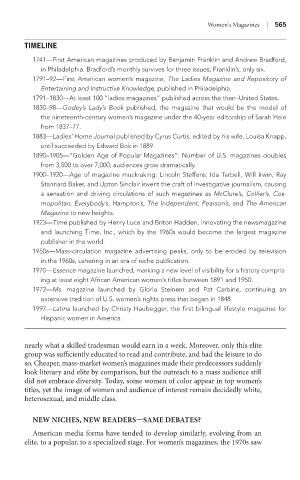Page 586 - Battleground The Media Volume 1 and 2
P. 586
Women’s Magaz nes |
tiMeline
1741—First American magazines produced by Benjamin Franklin and Andrew Bradford,
in Philadelphia. Bradford’s monthly survives for three issues; Franklin’s, only six.
1791–92—First American women’s magazine, The Ladies Magazine and Repository of
Entertaining and Instructive Knowledge, published in Philadelphia.
1791–1830—At least 100 “ladies magazines” published across the then–United States.
1830–98—Godey’s Lady’s Book published, the magazine that would be the model of
the nineteenth-century women’s magazine under the 40-year editorship of Sarah Hale
from 1837–77.
1883—Ladies’ Home Journal published by Cyrus Curtis, edited by his wife, Louisa Knapp,
until succeeded by Edward Bok in 1889.
1890–1905—“Golden Age of Popular Magazines”: Number of U.S. magazines doubles
from 3,500 to over 7,000; audiences grow dramatically.
1900–1920—Age of magazine muckraking: Lincoln Steffens, Ida Tarbell, Will Irwin, Ray
Stannard Baker, and Upton Sinclair invent the craft of investigative journalism, causing
a sensation and driving circulations of such magazines as McClure’s, Collier’s, Cos-
mopolitan, Everybody’s, Hampton’s, The Independent, Pearson’s, and The American
Magazine to new heights.
1923—Time published by Henry Luce and Briton Hadden, innovating the newsmagazine
and launching Time, Inc., which by the 1960s would become the largest magazine
publisher in the world.
1950s—Mass-circulation magazine advertising peaks, only to be eroded by television
in the 1960s, ushering in an era of niche publication.
1970—Essence magazine launched, marking a new level of visibility for a history compris-
ing at least eight African American women’s titles between 1891 and 1950.
1972—Ms. magazine launched by Gloria Steinem and Pat Carbine, continuing an
extensive tradition of U.S. women’s rights press that began in 1848.
1997—Latina launched by Christy Haubegger, the first bilingual lifestyle magazine for
Hispanic women in America.
nearly what a skilled tradesman would earn in a week. Moreover, only this elite
group was sufficiently educated to read and contribute, and had the leisure to do
so. Cheaper, mass-market women’s magazines made their predecessors suddenly
look literary and elite by comparison, but the outreach to a mass audience still
did not embrace diversity. Today, some women of color appear in top women’s
titles, yet the image of women and audience of interest remain decidedly white,
heterosexual, and middle class.
nEw niChEs, nEw rEaDErs—samE DEBaTEs?
American media forms have tended to develop similarly, evolving from an
elite, to a popular, to a specialized stage. For women’s magazines, the 1970s saw

